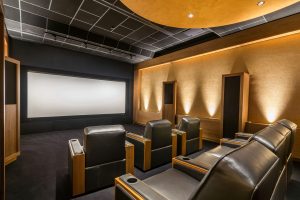Acoustic Solutions for Restaurants
There are all kinds of sounds to contend with in a bustling restaurant environment, from pots and pans clanging in the kitchen to gregarious guests interacting with their groups of friends. As these sounds start layering on top of one another, it’s easy to see how important sound insulation is to the comfort levels in restaurants.
Dining out should be more than just a great meal. It should be a feast for all the senses. Many restauranteurs understand the value of providing quality food in a cool atmosphere, but far too many forget about how the sound affects the overall experience. Restaurant background noise quality is a big part of what we look for in a great restaurant. Let’s look at how to improve it at your place.
Why is sound insulation important?
Alongside poor service and bad food, loud restaurant noise is the most common complaint among diners. An abundance of noise can push us to eat quickly and head out to somewhere more intimate. It can also negatively impact the food experience. When we go to a noisy restaurant with food, that’s just okay. We don’t itch to go back. Acoustically treating the space is necessary when creating an atmosphere that people want to linger in and return to.
If your restaurant is already set up with the ideal acoustical layout, consider yourself lucky. Most of us have to treat the room to make it sound great.
Basics of restaurant noise reduction
While a busy restaurant buzzing with people having a pleasant evening out can make us feel like we are part of a vibrant community, none of us want to shout over our meals or struggle to hear our friends. The key is to find a good balance.
The problem with finding that balance often comes in the form of the space itself. Many of the new restaurants that have popped up over the past decade or two have featured modern, industrial decor. It looks great, but all those hard, reflective surfaces create audio issues. Echoes and reverberation can amplify the restaurant noise generated by your guests, employees, and machinery. This creates an atmosphere where conversations become louder to compensate. This only intensifies the noise.
In order to reduce the noise level, restaurants must integrate soft, porous materials into their designs. Breaking up large swaths of hard surfaces is a must. You can break up some of these areas with tablecloths, area rugs, and soft furniture. Still, if you really want to dial into the ideal dining experience, you can’t beat the high density professional acoustical treatments that absorb and trap sounds before they become problematic.
What are the best sound insulation products for restaurants?
Many people ask which product will give them the biggest bang for their buck and deliver the most noticeable difference in their noise levels. The problem is that this question can be pretty subjective, and the answer has a lot to do with the specific qualities of the room and the primary source of nuisance noise. That said, there are several products that generally work very well in restaurant settings and are designed to make the interior look as great as it sounds.
Fabric wrapped acoustic panels
One solution that’s popular in the service industry is fabric wrapped acoustic panels. They’re an excellent option for fitting your reflective walls with a sound absorbing material. You can get them in various sizes and styles, so your sound insulation looks more like custom made artwork than a simple piece of functional fabric. If you want something more personal, you can print nearly anything you like on them these days, meaning you can create a gallery that showcases your brand and the important things to you and your restaurant family.
Ceiling clouds
Suspending fabric wrapped acoustical ceiling panels from the ceiling is a great way to add a splash of color to an otherwise drab ceiling and net you some solid sound insulation to boot. They can hide the sights and sounds of pipes and ductwork from your guests and give them something to talk about. While they are talking, those ceiling clouds will absorb some of that sound, reducing echo and reverberation in the room.
Dealing with external noise sources
Sometimes, the location of a restaurant can open it up to noise sources that come from outside the business. Whether that noise comes from a busy street that passes by the front windows, a busy airplane path overhead, or neighboring businesses within the building, the way to combat external noise sources is by creating a soundproof barrier between your space and the outside world.
Noisy neighbors
When we share buildings with others, sometimes we have to deal with noise passing through shared walls or ceilings. Soundproofing restaurant ceilings and walls is an excellent way to keep those sounds where they belong.
If your restaurant sits directly below another business, and that business involves people or things being moved around all day, you may have to deal with constant creaks. If possible, adding a floor underlayment and a layer of green glue to the floor above you will help a lot. If you aren’t able to do so because you don’t own the building or the space is already occupied, utilizing the ceiling clouds mentioned earlier may be your best soundproofing insulation option.
You can use a similar setup for your walls. Adding green glue and a second layer of drywall to your existing drywall can add mass and a gap, meaning less sound passes through your walls. You can also add insulation to your walls. This also adds mass but will absorb some of the sound waves as they pass through the walls.
Street sounds
If your restaurant is on a busy street, large front windows can be a great way to let the sun in and connect with your community, but they can also let in a lot of unwanted noise.
If you’re dealing with a new space, where you will design and build from the ground up, double glazed windows will keep a good deal of the sound out. The two panes are separated by a gap that’s generally filled with a gas, and they add tremendous sound and draft blocking abilities.
If you’re working with an existing space and have beautiful windows that you would rather not replace, window inserts are a good option. They fit snugly into the window frame or jamb and allow you to maintain your current windows. They’ll keep the noise down, and they’ll make your heating and cooling systems more efficient to boot.
Making a plan
Sometimes it can be hard to identify exactly where your problem noises are coming from, and other times it’s quite obvious. Sounds can come from so many places. It’s best to put a plan in place. Likewise, your solutions come in many different forms. Do you need soundproof wall insulation? How about soundproof ceiling insulation? It can be hard to tell if you aren’t familiar with how sound waves work.
Consulting a professional will help you narrow your needs down to the best sound insulation products for your business. Once you get your restaurant sounding great, people will spend more time and money there, and best of all, they’ll return and do it again.

















Leave a reply
You must be logged in to post a comment.